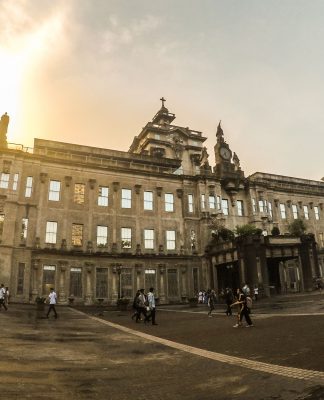A GOLD-COLORED “passport” and a ceremonial walk under the historic Arch of the Centuries—welcome to college life, UST-style.
Beginning a new chapter in one's student life at UST can be more memorable with a couple of ceremonial gestures freshmen look forward at the start of the academic year.
“Rituals are important. They are very meaningful to the lives of people. They symbolize something deeper. These are external signs of values of attitudes that we have, and these rituals symbolize our character and our identity,” said Evelyn Songco, assistant to the rector for student affairs.
Thomasian Journey Passport
As part of its Quadricentennial Celebration, the University started a commemorative project in 2010 for freshmen to keep track of their UST life. A gold-colored passport was issued by Theology professors to students to document people and events they come across with during their stay in UST.
This project, called the Thomasian Journey Passport, was the brainchild of Fr. Filemon dela Cruz, O.P., vice rector for religious affairs, Theology professors and other departments of the University. The passports were modified replicas of Philippine passports that served as a journal of the memorable events here.
The Office of Student Affairs released collectible stamps kept inside the passport to mark the student’s attendance in the different social activities happening around the University.
“It was really meant for the students to document their journey in the University, because if one has these [stamps] when they graduate, it really is evidence on their part on how well they lived their life in UST,” Songco said.
She said the more stamps collected, the more Thomasian memories earned.
“At siyempre, yung feeling mo na marami kang nasalihan na activities, mas marami kang opportunities na tinake for Thomasianformation,” Songco said.
But the issuance of the stamps stopped before the academic year ended.
Songco said when the project was discontinued, Fr. dela Cruz went abroad to study and since, was never updated. There are still no plans to revive the passports and stamps.
Rite of passage
Students in their complete uniforms held vibrant balloons and displayed other creative gimmicks—the usual picture of the new generation passing through the Arch of the Centuries.
Although it has been considered a tradition, this memorable parade of freshmen known as the Thomasian Welcome Walk is relatively new.
According to Songco, it was first introduced as the "Rite of Passage" in 2002 and was then led by Secretary General Fr. Winston Cabading, O.P. in collaboration with the Central Student Council.
She also said that this event, formally renamed in 2004, created an imprint both to freshmen and Thomasian graduates.
“The ritual is something very symbolic for the students. It is something that creates a bond between them and the University. If you do not participate, you will miss something valuable.”
The Welcome Walk was delayed several times last year but was finally pushed through on September 24 with two batches of freshmen entering the historical arch.
“There’s a feeling that the experience is not complete when you do not participate in the ritual,” Songco said.
For Thomasian graduates, their journey comes full circle with their emotional exit out the Arch of the Centuries.
“There is a feeling of intense emotions as one walks out the arch, both as a group and as an individual,” Songco said.
Because of its symbolic relevance, the arch also became subject to a very popular myth. It is said that a student would not complete his or her stay in the University once they pass out of the arch as an undergraduate.
Songco said that students created this myth because they wish to complete the cycle of entering and leaving the University as normal as possible.
“Only UST has the Arch of the Centuries, and when you partake in these rituals, you become part of history.”
Prof. Augusto De Viana, chair of the Department of History, recalled only college orientations during his time in the 80s.
He said they would only walk around in their respective college buildings back then while familiarizing themselves with the facilities.
“Before, we were only oriented in the campus, starting with the Main Building. Now, the Thomasian Walk has become formal because of rituals. What I only saw in pictures were the dunce caps of freshmen [back then],” De Viana said.
He said that these scheduled orientations were meant to formally open the doors of the University to the students, especially those from the provinces.
“It is very symbolic when they enter their respective buildings, and they’re not allowed to step out yet because they are not yet a product of it,” said De Viana.
He also said that UST respect the symbolisms of the Walk because they are important to Thomasians, especially now that the event has been formalized.
Songco said the Thomasian Journey is marked by the entrance and exit from the arch and every good memory that happened in between.
“What’s important is the students’ experiences in the University from the moment they first step on its grounds,” said Songco.
















